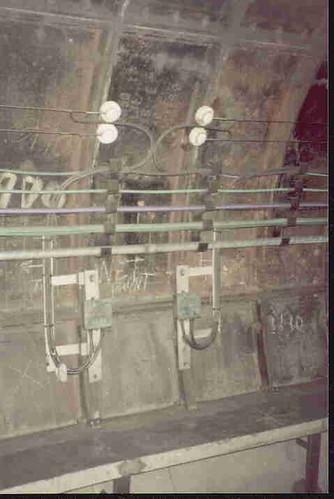
(Click on map for larger view)
London Underground Map 2015 (Transport for London).
When I was quite young, I was introduced to the London Underground on a visit to London with my parents. I think I was terrified and fascinated in equal parts. Terrified by the speed, the noise and descending into the bowels of the earth to board the trains - fascinated by the frequency of trains and the relative ease of moving underground around London. As an adult, I was happy to utilise the tube but it never had the attraction of steam railways. Even after my firm started supplying special-purpose telephone equipment for railways in various countries, I saw the London Underground network merely as a means of transport, not a potential source of work.
That changed in, I think, 1995 when one of our major customers, who was bidding for a large telecommunications package in connection with the Jubilee Line Extension Project, asked us to quote for the design and supply of Tunnel Telephone equipment. Well, I had a vague idea of what was involved - most people travelling on the Tube notice the pair of bare wires carried on the tunnel wall forming part of the tunnel telephone system. These wires allow the driver to attach a portable telephone in case of emergency. None of the telephone systems we'd produced seemed adaptable to this tunnel telephone application and I thought that the costs of developing suitable equipment from scratch would make any offer we made unattractive. So we declined to quote, explaining our reason to our customer.
However, a few months later the customer came back to us, saying they'd really like us to quote, and this time we produced a quotation. Some time later (these things always seem to take an inordinate time to come to fruition - a large quotation we did for Brazil only produced an order after seven years!) we agreed a contract to design and supply the necessary tunnel telephone equipment for the Jubilee Line Extension. I then embarked on a fairly steep learning curve to better understand both the traction supply system on London Underground and the requirements for tunnel telephone systems. As we produced the necessary equipment, I became far more interested in the history and development of the London Underground system. Over the years since, I've worked on tunnel telephone systems for a number of the London Underground lines and, as time permits, I'll add more posts on this unique mass transit system.
Brief Introduction
The London Underground employs a fairly unusual fourth-rail system of electrification. I've written a little about how traction current is distributed in the post London Underground - Traction Power Distribution and there's a short background in the post Fourth Rail Electrification.
Tunnel Telephone systems used on London Underground have two functions - to discharge traction current in an emergency and allow the driver to talk to the Line Control Centre (now generally called the 'Service Control Centre'). The tunnel wires allow a driver to open the cab window and simply 'pinch' the two bare wires together (the bare tunnel wires are sometimes referred to as 'pinch wires'). This action automatically discharges the local traction section. Connecting a portable telephone to the exposed wires similarly discharges the traction section, after which a conversation with the control centre is possible. Fixed telephones with a similar function are provided at strategic locations (such as the Headwalls at stations). London Underground now call the Tunnel Telephone system the Emergency Traction Current Discharge System (ETCDS) to better-reflect its principal function. Providing speech with the control centre, in this age of Secure Cab Communication by radio, is the secondary role.

Jubilee Line: Tunnel wires mounted on cast iron tunnel lining at the junction of two adjacent Tunnel Telephone sections.
Clive's UndergrounD Line Guides form an excellent reference to all of London Underground.
For track diagrams of London Underground, refer to 'Railway Track Diagrams Book 5: Southern and TfL' Third Edition, published by TRACKmaps (ISBN 978-0-9549866-4-3).
Books
Here's a list of some of the books I've acquired dealing with London Underground:-
[ 1] 'The Waterloo & City Railway' by John C. Gillham (The Oakwood Press) ISBN 0 85361 544 6.Related posts on this website
[ 2] ‘Railways of Waterloo’ by J. N. Faulkner (Ian Allen Publishing) ISBN 0 7110 2237 2.
[ 3] ‘London’s Local Railways’ by Alan A Jackson (David and Charles) ISBN 0-7153-7479-6.
[ 4] ‘Steam to Silver – An illustrated history of London Transport railway surface rolling stock’ by J. Graeme Bruce (London Transport) published 1970.
[ 5] ‘Inside Underground Railways’ by Alan A. Jackson (Ian Allen Ltd.) published 1964.
[ 6] ‘The London Underground – A diagrammatic history’ by Douglas Rose (Douglas Rose) 3rd edition ISBN 0 9507101 5 6.
[ 7] ‘Underground Train Overhaul – The Story of Acton Works’ by J. Graeme Bruce/Piers Connor (Capital Transport Publishing) ISBN 1 85414 134 1.
[ 8] ‘The Northern Line – An illustrated history’ by Mike Horne/Bob Bayman (Capital Transport Publishing) 2nd edition 1999 ISBN 1 85414 208 9.
[ 9] ‘The Story of London’s Underground’ (London Transport) revised edition 1966.
[10] ‘British Electric Trains’ by H. W. A. Linecar (Ian Allen) 2nd edition 1949.
[11] ‘Handling London’s Underground Traffic’ by J. P. Thomas (London Underground) published 1928.
[12] ‘The London Underground Tube Stock’ by J. Graeme Bruce (Ian Allen Ltd.) ISBN 0 7110 1707 7.
[13] 'Railway Track Diagrams Book 5: Southern and TfL' Third Edition, published by TRACKmaps (ISBN 978-0-9549866-4-3).
[14] ‘London Underground Guide 2015’ by Jason Cross (Train Crazy Publishing 2015) ISBN 978-1-907648-10-6.
All my posts on London Underground can be found here.
My pictures
My coverage of London Underground lines is very patchy and quality is generally rather poor, I'm afraid. All these albums are shown here.
[Book {14} added to book list 11-Apr-2021]
